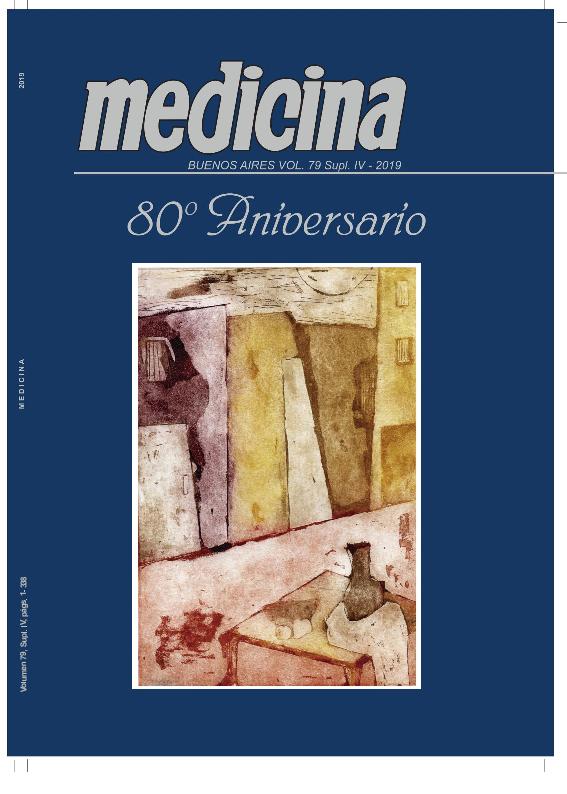Evento
Protective effect of Enterococcus faecalis CECT7121 against Trichinella spiralis infection in mice
Schofs, Laureano ; Sparo, Mónica Delfina; Delpech, Gastón
; Sparo, Mónica Delfina; Delpech, Gastón ; Dominguez, Maria Paula
; Dominguez, Maria Paula ; Ceci, Monica Andrea; Lissarrague, Sabina; de Yaniz, María Guadalupe
; Ceci, Monica Andrea; Lissarrague, Sabina; de Yaniz, María Guadalupe ; Sanchez Bruni, Sergio Fabian
; Sanchez Bruni, Sergio Fabian
 ; Sparo, Mónica Delfina; Delpech, Gastón
; Sparo, Mónica Delfina; Delpech, Gastón ; Dominguez, Maria Paula
; Dominguez, Maria Paula ; Ceci, Monica Andrea; Lissarrague, Sabina; de Yaniz, María Guadalupe
; Ceci, Monica Andrea; Lissarrague, Sabina; de Yaniz, María Guadalupe ; Sanchez Bruni, Sergio Fabian
; Sanchez Bruni, Sergio Fabian
Tipo del evento:
Reunión
Nombre del evento:
LXIV Reunión Anual de la Sociedad Argentina de Investigación Clínica; LI Reunión Anual de la Asociación Argentina de Farmacología Experimental; XXI Reunión Anual de la Sociedad Argentina de Biología; XXXI Reunión Anual de la Sociedad Argentina de Protozoología; IX Reunión Anual de la Asociación Argentina de Nanomedicinas y VI Reunión Científica Regional de la Asociación Argentina de Ciencia y Tecnología de Animales de Laboratorio
Fecha del evento:
13/11/2019
Institución Organizadora:
Sociedad Argentina de Investigación Clínica;
Asociación Argentina de Farmacología Experimental;
Sociedad Argentina de Biología;
Sociedad Argentina de Protozoología;
Asociación Argentina de Nanomedicinas;
Asociación Argentina de Ciencia y Tecnología de Animales de Laboratorio;
Título de la revista:
Medicina (Buenos Aires)
Editorial:
Fundación Revista Medicina
ISSN:
0025-7680
Idioma:
Inglés
Clasificación temática:
Resumen
Trichinellosis is an important parasitic zoonosis produced by the ingestion of raw or undercooked meat infected by Trichinella spiralis larvae. At the present, the pharmacological treatment against Trichinellosis in human is unsuccessful. Therefore, the potential of viable Enterococcus faecalis CECT7121 culture, administered by oral route, in mice against T. spiralis infection was evaluated. Eighteen BALB/C mice were divided in two groups (n=9) as follow: A- Experimental Group: E. faecalis CECT7121 strains were administered daily in a dose of 10 9 UFC/mL in 300 µL for five consecutive days. B-Negative control Group: animals received 300 µL of sterile sodium chloride. On day 5 of treatment, whole mice were infected with 450 T. spiralis larvae. Four mice, from both experimental and control group, were sacrificed on day 6 post infection for assessing the amount of T. spiralis adults from the small intestine. At day 28 post infection the remaining mice from each group were sacrificed and the tongue processed in order to estimate the muscle larval burden in that tissue, used as surrogate marker of the number of larvae per g (LPG) of tissue. The test used for groups statistical comparison was Mann- Whitney. A difference of p< 0.05 was considered significant. The average number of recovered T. spiralis adult worms? from the intestinal content was 105 (± 46) for the treated group and 80 (±42) in control group, resulting in non- significant 24% of reduction (p>0.05). However, the percentage of LPG reductions obtained in tongue tissue after 28 days post- infection increased 62% (p <0.01) in mice treated with E. faecalis CECT7121 as preventive. The quantification of T. spiralis adults in the intestinal content alone was not indicative of presence or absence of protective response when compared with samples obtained from mice tongue tissue. The protective response of E. faecalis CECT7121 against T. spiralis infection will be a contribution to improve the conventional therapeutic against Trichinellosis.
Palabras clave:
Enterococcus faecalis CECT7121
,
Trichinella spiralis
,
Mice
Archivos asociados
Licencia
Identificadores
Colecciones
Eventos(CIVETAN)
Eventos de CENTRO DE INVESTIGACION VETERINARIA DE TANDIL
Eventos de CENTRO DE INVESTIGACION VETERINARIA DE TANDIL
Citación
Protective effect of Enterococcus faecalis CECT7121 against Trichinella spiralis infection in mice; LXIV Reunión Anual de la Sociedad Argentina de Investigación Clínica; LI Reunión Anual de la Asociación Argentina de Farmacología Experimental; XXI Reunión Anual de la Sociedad Argentina de Biología; XXXI Reunión Anual de la Sociedad Argentina de Protozoología; IX Reunión Anual de la Asociación Argentina de Nanomedicinas y VI Reunión Científica Regional de la Asociación Argentina de Ciencia y Tecnología de Animales de Laboratorio; Mar del Plata; Argentina; 2019; 183-183
Compartir



